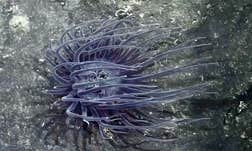Like other cold-blooded reptiles, giant tortoises use the environment around them to regulate their body temperature. On Isabela Island—the largest in Ecuador’s Galápagos archipelago—Alcedo giant tortoises (Chelonoidis vandenburghi) dig basins to capture and store rainwater long after storms cease. Wallowing in the murky pools moistens the tortoises’ skin and helps rid them of ticks. And because the mud holds heat from the day’s sunshine, it helps the tortoises stay warm when nights get chilly in the caldera of the Alcedo Volcano, which rises more than 3,000 feet above the tropical sea.
Digging communal baths isn’t the only way that giant tortoises engineer the ecosystems around them. In part because of their size (males can grow to 500 pounds), and in part because of their longevity (Galápagos tortoises commonly live more than 100 years), the creatures have an outsized impact on the islands where they are endemic. They make permanent paths and furrows with their travels, disperse the seeds of flowering plants with their poop, and maintain open meadows like reptilian lawnmowers.
Everything on Alcedo seems to happen on tortoise time.
For decades, though, goats and donkeys introduced by whalers and other mariners made life hard for Alcedo giant tortoises, as well as the other two tortoise species that live on Isabela Island. The non-native herbivores munched through forests of guayabillo trees, high-altitude tree ferns, and other vegetation. By the 1990s, more than 100,000 goats and donkeys had defoliated northern Isabela Island to a near-desert, leaving little forage for slow-moving tortoises.
Worse, tortoise populations were still reeling from another major blow. Sailors who passed through the Galápagos in the 18th and 19th centuries captured up to 200,000 live tortoises and packed them into their ships. Because the tortoises could survive months at sea without eating or drinking, sailors could kill one whenever they got hungry, ensuring a fresh supply of meat on long voyages. Two of the archipelago’s 12 tortoise species went extinct, and six more remain critically endangered.
In 1959, the Ecuadorian government established Galápagos National Park to help protect the remaining tortoises and other unique species, and in 2006, an ambitious program succeeded in eradicating goats and donkeys from northern Isabela Island. Today, although Alcedo giant tortoises are still listed as vulnerable by the International Union for Conservation of Nature, their population is growing. Scientists with the nonprofit Galápagos Conservancy recorded more than 15,000 Alcedo tortoises plodding, grazing, and wallowing on the volcano’s slopes, including a flush of juveniles in areas never before surveyed. The figure is a dramatic jump from the IUCN’s 2015 estimate of 6,320 mature individuals.
Two of the archipelago’s 12 tortoise species went extinct.
Photographer Tui De Roy has been fortunate enough to witness the tortoises’ comeback. In the five decades she’s spent photographing in the Galápagos, De Roy has hiked the Alcedo Volcano hundreds of times—in drought and deluge, on clear nights and foggy ones, at times when the air was filled with the grunts of mating tortoises and during dry spells when the animals were nearly dormant. “Everything on Alcedo seems to happen on tortoise time,” De Roy writes in her book A Lifetime in Galápagos. When she’s there, she moves more slowly, too, taking her time to compose the perfect shot.
One year when the seasonal rains had stopped but the pools dug by tortoises still held water, De Roy was camped solo in the Alcedo caldera, her tent hidden behind bushes. As the sun sank behind the volcano’s rim, she captured this image of Alcedo tortoises gathering in the liquid sunshine of a mud pool, as they have since long before humans set foot on this island and as they hopefully will for many generations to come. ![]()
This story originally appeared in bioGraphic, an independent magazine about nature and regeneration powered by the California Academy of Sciences.
Tui De Roy is an internationally recognized wildlife photographer, naturalist, writer, and conservationist. Originally from Europe, she grew up in the Galápagos Islands, where her pioneering family settled more than 60 years ago. De Roy travels the world, documenting wildlife and wilderness in the most pristine, uninhabited regions of our planet, and has published many photo books, including Albatross: Their World, Their Ways, which covers all 22 albatross species.




























